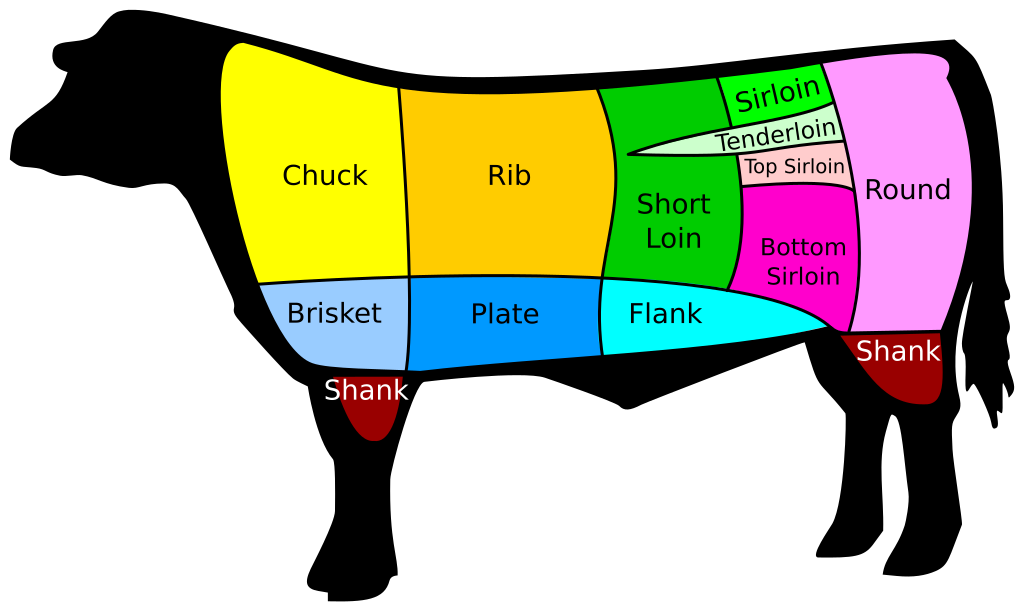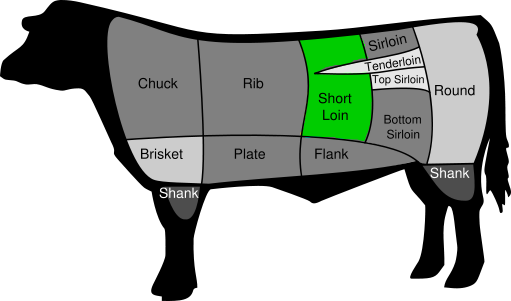Cuts of Meat

"Steak" is a catchall word that describes a cut of meat. Though some animals have different cuts based on their anatomy, beef is a good place to start with as found is just about every butcher counter, and has some complex muscle areas where meat is harvested from not found in other animals.
Why are some steaks so expensive?
Taking a look at a butcher's diagram of cattle we can see there are many sections where steaks are cut from.

source - wikipedia
The reason there are so many different regions that cuts of meat come from is related to the amount of use that part of the animal gets, how the fat is distributed, and the amount of meat to harvest in each region. Knowing this we can understand and explore why some steaks are more expensive than others:
Tenderness
All animals have muscles that are more exercised than others, and the more a muscle is used the tougher the meat. Tender selections of meat comes from a part of the animal that doesn't receive much exercise, typically high up and close to the rear.
Fat
When talking about meat the amount of fat that a cut has is important, since this is where the flavor come from. When looking at meat you will see fat in wide strips around or through the cut, or marbled throughout.

Fat marbled throughout
When looking at steaks these are the two most important things to consider. Unsurprisingly cuts with premium qualities represent a small percentage of all the meat on the animal, and are usually expensive.
So, which cut is the best?
This all depends on what you like in steak, hearty beefy flavor, a soft texture, or a mix of both? Let's take a look at 5 very common cuts of beef and examine how they are different.
Strip Steak

Strip steak (also called New York strip steak, or sirloin steak)
From the short loin section, an area where the muscle does little work, which means the meat is tender. A hallmark of the strip steak is the elongated shape and the pronounced fat cap running along most of the top.

source - wikipedia
Strip steaks are partially marbled, giving good flavor throughout, and the fat cap can be rendered during cooking to give even more flavor. This cut is great for grilling or the skillet where high heat can render the fat and produce good flavor, these steaks can usually be found in smaller portions.
Tenderloin

The Tenderloin (also called fillet steak)
Cut from a very specific area near the kidneys, and has an oblong shape. This particular muscle area does very little work; making the meat quite tender (hence the name).

source - wikipedia
Most tenderloins have minimal fat and very little marbling, making this cut tender and suitable for rare steaks, but lacking in big flavor when compared to other cuts. Due to its tenderness, this cut is also good for dishes like Stroganoff.
T-Bone

The T-bone steak (also known as porterhouse)
The "T" shape of the bone that comes with this cut and has meat on both sides. Cut from the short loin, this steak has good fat content and is also tender.

source - wikipedia
The T-bone is actually 2 steaks in one: A strip steak with the identifiable fat cap along the top on one side of the bone, and a smaller section of tenderloin on the other. The anatomy of this steak makes it desirable because it has the fat benefits of the strip steak and the tenderness of the tenderloin. This cut is great for the grill or skillet.
Ribeye

Ribeye (also called Rib Eye, or Scotch fillet)
High fat marbling throughout with large fat deposits, sometimes bought bone-in (called "cowboy cut").

source - wikipedia
In my opinion, this is the best cut of meat. With both tender and lots of fat, this cut produces great steaks any way you cook it.
Chuck

Cut from the area behind the head, chuck is an economical cut as the muscle area is heavily used making it a tougher cut of meat.

source - wikipedia
While it usually has good marbling, chuck also has lots of connective tissue which needs to be rendered in order to be eaten. It is therefore typically used for slow cooking like pot roasts and braising - this is also the cut we'll use in the Smoker Lesson. Alternatively, chuck is commonly ground up and used in hamburger patties, since the grinding breaks the connective tissue and renders the meat very tender.
Quality Grades
Every country has their own method and ranking of beef quality. In the USA this is known as the United States Department of Agriculture Grading (USDA).
USDA beef quality is determined by 2 factors: marbling (the fat distribution in the cut), and maturity (meaning the health of the animal rather than the actual age).
USDA grading is ranked highest to lowest: Prime, Choice, Select, Standard.
Within these rankings there are degrees, from highest to lowest: +, °, -
Meaning the highest ranked beef cut is Prime + and the lowest is Standard –
Here's a breakdown from the USDA:

source - USDA
Quiz Time!
Think you got it all figured? Let's find out with a quick quiz:
{
"id": "quiz-1",
"question": "Tenderloin typically has good fat marbling",
"answers": [
{
"title": "True",
"correct": false
},
{
"title": "Tenderloin gets it's flavor from the bone",
"correct": false
},
{
"title": "False",
"correct": true
}
],
"correctNotice": "Correct! Tenderloin has very little fat, but is very tender.",
"incorrectNotice": "Try again."
}
{
"id": "quiz-2",
"question": "All beef cuts are the same quality",
"answers": [
{
"title": "True",
"correct": false
},
{
"title": "False",
"correct": true
}
],
"correctNotice": "Correct! All beef is ranked on fat marbling and the overall health of the animal",
"incorrectNotice": "Nope. An older animal will be in different health than a younger one, and may have different fat marbling."
}
{
"id": "quiz-3",
"question": "The weight and quality being equal, the price of steak is based on:",
"answers": [
{
"title": "Tenderness, fat",
"correct": true
},
{
"title": "Tenderness, fat, how many friends the cow had",
"correct": false
}
],
"correctNotice": "Yes!",
"incorrectNotice": "That would be nice, but not correct."
}
There's a lot to think about when it comes to cuts and quality of beef, I hope this lesson has shown you that not all cuts are created equal. Armed with this knowledge you'll be prepared to talk to your butcher with confidence about your next meal idea.
Since quality is tied to flavor, it pays to go armed with knowledge and select the best cuts based on your budget and desired meal.
Now that we know about what we're looking for, let's move onto some meat cooking basics!